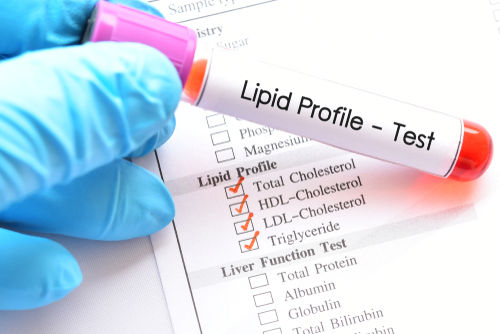General Health
Are You At Risk Of A Heart Disease? This Simple Test Can Say
5 min read
By Apollo 24|7, Published on - 17 June 2022, Updated on - 14 June 2023
Share this article
0
0 like

Thanks to unhealthy lifestyles and eating habits, high cholesterol has become one of the most common health issues these days. It is a well-known fact that high cholesterol levels can damage the blood vessels, resulting in heart disease and stroke. Doctors often recommend lipid profile panel tests to help determine the risk of heart disease by analyzing cholesterol in their blood. The article explains the lipid profile panel test in detail below.
What is a Lipid Profile Test?
A lipid profile test, more commonly known as a complete cholesterol test, helps measure the levels of cholesterol and other fats in the blood. Cholesterol is a waxy, fat-like substance (lipid) that is found in the blood. Our bodies need some cholesterol for certain biological functions such as the formation of cell membranes, hormones, and vitamin D. However, excess cholesterol in the blood can combine with cellular waste products, calcium, and fibrin to form plaques (fatty deposits) in your arteries. The accumulation of plaque in the arteries results in atherosclerosis, which hardens the arteries and increases the risk of:
- Heart diseases
- Heart attack
- Stroke
- Heart failure
What Does Lipid Profile Test Measure?
A lipid profile test usually measures the levels of four types of fats (lipids) in the blood:
1. Low-density lipoprotein (LDL) cholesterol: It is known as bad cholesterol. High levels of LDL cholesterol play a key role in the development of atherosclerosis. It is also a major risk factor for heart attack and stroke.
2. High-density lipoprotein (HDL) cholesterol: It is considered good cholesterol. HDL cholesterol helps get rid of LDL cholesterol, keeps arteries wide and facilitates the free flow of the blood.
3. Total cholesterol: This is the total sum of LDL cholesterol and HDL cholesterol in your blood.
4. Triglycerides: It is a type of fat found in the blood. The body transforms the excess calories into triglycerides, which are stored in fat cells. According to research, elevated levels of triglycerides are linked to a higher risk of heart disease, particularly in women.
Why Do You Need a Lipid Profile Test?
A lipid profile test is essential for you if you:
- Are aged 45 years or older
- Are obese

- Smoke
- Consume alcohol frequently
- Lead a sedentary lifestyle
- Have a family history of high cholesterol
- Have a medical condition such as diabetes, kidney disease, hypertension, polycystic ovary syndrome, or hypothyroidism
According to health experts, men aged 45 years and above and women aged 55 years and older should get a lipid profile test done every 4 to 5 years. On the other hand, children, adolescents, and young people should undergo a lipid profile test at least once between the ages of 9 and 11 and then again between the ages of 17 and 21.
What Happens During the Test?
The lipid profile test is an outpatient procedure that barely takes a few minutes. During the test, your phlebotomist will take a small sample of your blood from a vein in your arm. The sample is usually taken in the morning after an overnight period of fasting. In most cases, you are required to fast for 9 to 12 hours before the test. However, you should consult your healthcare provider to know more about what you need to do before and after the test.
Optimal Test Results
The ideal test results of a lipid profile test (measured in milligrams per deciliter of blood — mg/dL) for most adults are as follows:
- Low-density lipoprotein (LDL): Less than 100 mg/dL
- High-density lipoprotein (HDL): More than 60 mg/dL
- Total cholesterol: Less than 200 mg/dL
- Triglycerides: Less than 150 mg/dL
Can Lipid Profile Test Help Detect Heart Disease?
Your physician will use the results of your lipid profile test to assess your heart health. If your test results are higher than the ideal range, then it doesn't automatically imply that you have heart disease or need treatment. Higher levels suggest that if you don’t take active measures to lower your cholesterol, you may have an increased risk of developing atherosclerosis, heart disease, and stroke in the future. To determine your overall risk of heart disease, your physician will take into consideration other factors, such as your age, overall health, weight, medical history, and activity levels.
Ways to Lower Cholesterol Levels
It is possible to lower your cholesterol with lifestyle changes such as:
- If you smoke, then quit.

- Limit consumption of alcohol to not more than 2 drinks a day.
- If you are overweight or obese, then lose weight.
- Practise moderate-intensity exercise for at least 30 minutes daily.
- Avoid or limit intake of refined carbohydrates, fried foods, and sweetened beverages.
- Eat a well-balanced diet rich in vegetables, fruits, whole grains, low-fat dairy, and lean sources of protein.
A lipid profile test can determine the levels of cholesterol and other fats in your bloodstream. The results can help your physician decide whether you are at risk of developing heart disease or not. Experts say that every adult aged 45 years and older should get tested for cholesterol frequently. If you have high cholesterol, then you should consult your doctor to know more about what can be done to bring your cholesterol levels down.
Medically reviewed by Dr Sonia Bhatt.
General Health
Leave Comment
Recommended for you

General Health
Hypothyroidism Diet: Foods To Eat And Avoid
This article discusses the vegetables that people with hypothyroidism should be careful about, such as cruciferous vegetables, spinach, sweet potatoes, radishes, and soy. It also provides tips on how to prepare these vegetables to minimise their effects on thyroid hormone production.

General Health
4 Warning Signs of Conjunctivitis: Know When To Consult A Doctor
Learn about the 4 concerning signs of conjunctivitis, including redness, itching, discharge, and more. Stay informed and protect your eye from this contagious infection.

General Health
Your Weight Can Influence Vitamin D Absorption In Your Body! Know How
Did you know your weight could affect the amount of vitamin D you can absorb? Find out how different body sizes influence vitamin D absorption and get tips on ensuring you get the most out of your intake.
Subscribe
Sign up for our free Health Library Daily Newsletter
Get doctor-approved health tips, news, and more.
Visual Stories

Science-backed Home Remedies for Burns and Blisters
Tap to continue exploring
Recommended for you

General Health
Hypothyroidism Diet: Foods To Eat And Avoid
This article discusses the vegetables that people with hypothyroidism should be careful about, such as cruciferous vegetables, spinach, sweet potatoes, radishes, and soy. It also provides tips on how to prepare these vegetables to minimise their effects on thyroid hormone production.

General Health
4 Warning Signs of Conjunctivitis: Know When To Consult A Doctor
Learn about the 4 concerning signs of conjunctivitis, including redness, itching, discharge, and more. Stay informed and protect your eye from this contagious infection.

General Health
Your Weight Can Influence Vitamin D Absorption In Your Body! Know How
Did you know your weight could affect the amount of vitamin D you can absorb? Find out how different body sizes influence vitamin D absorption and get tips on ensuring you get the most out of your intake.
